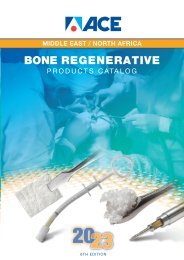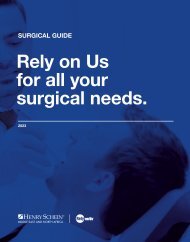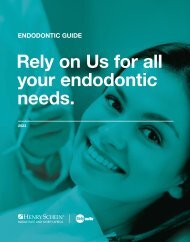Henry Schein MENA AEEDC Brochure 2023
Create successful ePaper yourself
Turn your PDF publications into a flip-book with our unique Google optimized e-Paper software.
Case 2<br />
Primary treatment of an upper second molar.<br />
Medical history:<br />
The 61-year-old patient presented for primary root canal treatment at 27 after referral by his general<br />
dentist. The tooth had been crowned about 2 years ago and the patient was symptom-free. In the course<br />
of the radiological check-up after apicoectomy of tooth 26, a periapical osteolysis had been detected on<br />
tooth 27.<br />
Clinical findings:<br />
Tooth 27 showed a sufficient restoration. No increased probing depths were palpable and both cold and<br />
percussion tests were negative.<br />
Radiographic findings:<br />
Tooth 27 shows periapical osteolysis in the sense of chronic apical periodontitis (Figure 6).<br />
Therapy:<br />
The primary endodontic treatment of tooth 27 was also performed in one session. After trephination, the<br />
initial intracoronal diagnosis and visualisation of the four canal orifices was performed using a long-neck<br />
carbide round bur. An EdgeFile X7 size 17.06 was used for coronal expansion of the canals. The creation<br />
of the glide path could be done purely mechanically. For this purpose, EdgeFile X7 sizes 17.04, 17.06<br />
were used in an alternating manner until the approximately radiographically determined preliminary<br />
working length was reached. After electrometric determination of the working length with C-Pilot files<br />
size 8 and 10, further preparation was carried out with EdgeFile X7 size 20.06, 25.06 and 30.06. After<br />
final preparation, the canals were rinsed with 17% EDTA for 60 seconds. As a final rinse 6% NaOCl was<br />
sonically activated. A masterpoint image was taken to verify the preparation and the fit of the adapted<br />
gutta-percha tips (figure 7). After drying with micro aspiration and paper tips, all canals were obturated<br />
with bioceramic sealer using a warm vertical filling technique (figure 8). Adhesive closure was carried out<br />
with Bulk Fill Flow composite (figure 9).<br />
Fig 6 Fig 7 Fig 8<br />
Fig 9<br />
Case 3<br />
Revision of an upper second molar<br />
Case history:<br />
A 54-year-old patient presented with acute complaints on tooth 27. He had been referred by his general<br />
dentist for further treatment after he had, according to his own statement, unsuccessfully searched for a<br />
second mesiobuccal canal.<br />
Clinical findings:<br />
Tooth 27 had a provisionally closed access cavity. The tooth responded positively to the percussion test<br />
and palpation of the vestibule revealed a pressure dolence in the area of the mesiobuccal root.<br />
Radiographic findings:<br />
The preoperative radiograph (Figure 10) shows tooth 27 already trephined by the previous practitioner.<br />
The root filling appears inhomogeneous. The root filling material in the mesiobuccal canal is extended<br />
beyond the radiographic apex and there is periapical osteolysis of the mesiobuccal root.<br />
Therapy:<br />
The revision treatment was carried out in two sessions. After placing the rubber dam, the temporary filling<br />
was removed, and the access cavity was cleaned. This was followed by intracoronal diagnostics (figure<br />
11). Bacterial colonized root filling material was found in the mesiobuccal, distobuccal and palatal canals.<br />
The orifice of the mesiobuccal canal was widened in the palatal direction. Removal of a mesial dentin<br />
overhang with a long-shaft round bur exposed the orifice of the second mesiobuccal canal, which was<br />
displaced far in the palatal direction. The root filling material was removed using EdgeFile X7 size 25.06<br />
and 17.06 in a crown-down technique to reduce the spread of germs and bacterial colonized root filling<br />
material apically. The opening and initial preparation of the second mesiobuccal canal was carried out<br />
using the EdgeFile X7 size 17.04, 17.06 in an alternating manner as described above. After electrometric<br />
determination of the working length of all canals, the preparation was continued with EdgeFile X7 at full<br />
working length. In the first mesiobuccal canal, distobuccal and palatal preparation was completed with<br />
EdgeFile X7 size 40.06, while the second mesiobuccal canal was prepared to 30.06 (Figure 13). After<br />
completion of the preparation, the canals were dried, calcium hydroxide was placed to full working length<br />
and the tooth was provisionally closed with an adhesive composite filling. Further treatment took place<br />
Fig 10 Fig 11<br />
Fig 12<br />
Fig 6: Preoperative diagnostic image<br />
Fig 7: Masterpoint image<br />
Fig 8: Control image after root canal filling<br />
Fig 9: Control image after adhesive closure<br />
Fig 10: Preoperative diagnostic image<br />
Fig 11: After working out the primary access cavity;<br />
showing the mb2 near the palatal canal.<br />
Fig 12: Masterpoint image<br />
8 9
















